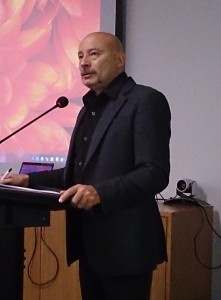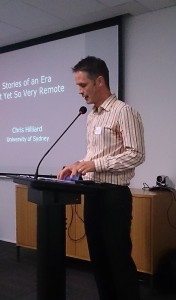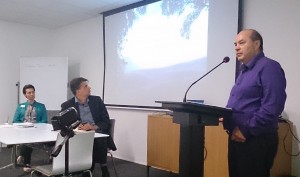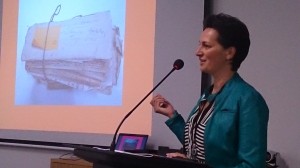A successful one-day symposium was held at the National Library on Friday 21 February, a joint event run by Annabel Cooper of the Centre for Research on Colonial Culture and Ariana Tikao of the Alexander Turnbull Library. It attracted more than 65 attendees, including academics, librarians, archivists, professional and governmental historians, and other interested people. Chief librarian of the Alexander Turnbull Library, Chris Szekely, welcomed people to the event, and suggested that it was a good start to CROCC’s relationship with the Turnbull and National Library, and hopefully the first of many events. Chris’s welcome was followed by a mihi from the Turnbull’s Curator Māori, Paul Diamond.
Chris Hilliard (University of Sydney) returned to Cowan, a subject of research earlier in his career, with the keynote address ‘Stories of an Era Not Yet So Very Remote’ in which he asked us to look beyond Cowan’s grand statements – ones with which he can so easily be tied to the colonial project – to his love of detail, and it was through these that we could get a better understanding of the man. Chris stressed Cowan’s love of New Zealand history, and his connection with place and people.
The themes that Chris set out were picked up by the three speakers who followed. Paul Meredith of Ngāti Maniapoto, like Cowan, grew up in the Kihikihi area, and values the writer’s work, in particular his oral history, as a means of unlocking the voices of his tūpuna. He pointed out too that Cowan collaborated with Raureti Te Huia and the methods they used have parallels with the kaupapa Māori methodology of today.
Te Kenehi Teira of Ngāti Raukawa, Kaihautu Māori for the Historic Places Trust, spoke about the Trust’s development of interpretation and other resources for the Ōrākau commemorations, and a smartphone driving app for the Waikato battle sites. As Te Kenehi said, the app was a means of bringing Cowan into the modern world. The researchers utilised Cowan’s writings as a means of adding detail to the interpretations, and in the case of Ōrākau, of pinpointing the actual site of the pā.
This session was closed by Ariana Tikao of Kāi Tahu, Research Librarian Māori, who discussed the Turnbulls’ recent acquisition and description of 202 folders of Cowan manuscript material (acquired at the end of 2012) that now complements the Library’s existing collection. Ariana also talked about putting together Borderland: The World of James Cowan, (running to 26 April in the Alexander Turnbull Gallery), her exhibition exploring the writer’s life, work and legacy.
After lunch, we heard from Greg Woods who talked on Cowan’s years as a journalist at the Auckland Star (1888-1903). During this time Cowan wrote at least 370 feature articles, some of which he incorporated into his later books. Cowan was a “Māori specialist” perhaps due to his language skills, and unlike most reporters of the time, was able to add his name to these articles. While also shipping reporter Cowan met some famous writers, such as Rudyard Kipling, Mark Twain and Robert Louis Stevenson, and Greg argued that Cowan took Stevenson as a sort of literary model for his writing. Kathryn Parsons, Special Collections Librarian at the University of Waikato, discussed Cowan’s later writing for children in The Enzed Junior, a weekly Saturday supplement that ran from 1934 to 1941. Cowan wrote 255 articles for this publication, 190 of which were on Māori-related topics. Staying with young people, the final speaker in this session, Jim Frood, a history teacher at Kings College, Auckland spoke on the secondary schools history curriculum and the value of Cowan’s work as a resource in the teaching of Year 11-13 history.
Roger Blackley of VUW began the last session with a discussion on Pictures of Old New Zealand, comprising Lindauer portraits of Māori men and women with bibliographical information supplied by Cowan. Roger showed how Cowan re-used text written by earlier writers, such as James Mackay, but moderating some of the sentiments for the sensibilities of his own day. Although Cowan’s writing is about the people, rather than the art itself, Roger argued that Pictures of Old New Zealand might be considered New Zealand’s first art monograph. Lydia Wevers (Stout Centre, VUW) then spoke about Cowan’s travel writing, in particular his work on the Main Trunk Line written for railway tourism purposes. This work shows Cowan’s contradictory attitudes to colonialism, on the one hand accepting the inevitable march of progress, while also lamenting the loss of the bush, and the old Māori ways of life. Annabel Cooper (University of Otago) and Diane Pivac from New Zealand Film Archive, looked at Cowan’s influence on New Zealand films of the New Zealand Wars, from Rudall Hayward (for whom he worked as an advisor) to Geoff Murphy’s Utu, which was inspired by one of Cowan’s stories, to Vincent Ward’s River Queen. We were treated to excerpts from Hayward’s Te Kooti Trail, a silent movie in which Hayward used descendants of the historical figures as actors, and his last movie, Rewi’s Last Stand. Tony Ballantyne (University of Otago and CROCC Director) wrapped up the day, reminding us that Cowan is a more complex personality than superficial reading of his work might suggest.





